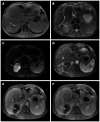Primary hepatic angiosarcoma: A report of two cases and literature review
- PMID: 26019478
- PMCID: PMC4438048
- DOI: 10.3748/wjg.v21.i19.6088
Primary hepatic angiosarcoma: A report of two cases and literature review
Abstract
Primary hepatic angiosarcoma (PHA) is a rare malignancy that carries a poor prognosis. Of 1500 patients who underwent hepatectomy for primary hepatic tumors between 1994 and 2013 at our center, two patients were pathologically diagnosed with PHA. Clinical characteristics, treatment modalities, and outcomes of the two patients were collected and analyzed. Both patients underwent hepatectomy and had a postoperative survival time of 8 and 16 mo, respectively. A search of PubMed yielded eight references reporting 35 cases of PHA published between 2004 and 2013. On the basis of the presented cases and review of the literature, we endorse complete surgical resection as the mainstay definitive treatment of PHA, with adjuvant postoperative chemotherapy potentially improving survival. Palliative chemotherapy is an option in advanced hepatic angiosarcoma.
Keywords: Diagnosis; Hemangiosarcoma; Liver; Surgery; Therapy.
Figures






References
-
- Mani H, Van Thiel DH. Mesenchymal tumors of the liver. Clin Liver Dis. 2001;5:219–257, viii. - PubMed
-
- Molina E, Hernandez A. Clinical manifestations of primary hepatic angiosarcoma. Dig Dis Sci. 2003;48:677–682. - PubMed
-
- Block JB. Angiosarcoma of the liver following vinyl chloride exposure. JAMA. 1974;229:53–54. - PubMed
-
- Bioulac-Sage P, Laumonier H, Laurent C, Blanc JF, Balabaud C. Benign and malignant vascular tumors of the liver in adults. Semin Liver Dis. 2008;28:302–314. - PubMed
Publication types
MeSH terms
Substances
LinkOut - more resources
Full Text Sources
Other Literature Sources
Medical

